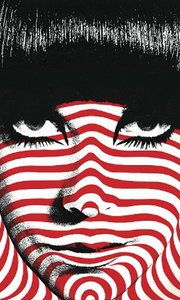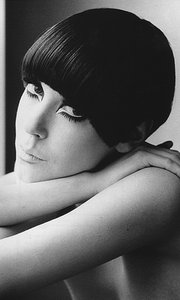Peggy Moffitt-Still Inspiring Fashion
Peggy Moffitt will be both the subject and the guest when the Otis College of Art and Design presents the second seminar in its “Inside the Designer’s Studio” series on March 25 at the California Market Center in Los Angeles.
Both model and muse, Moffitt is the statuesque beauty whose signature jetblack bob and kohl-rimmed eyes helped define the ’60s.
The 66-year-old Los Angeles native studied acting in New York, where she attended acting classes and appeared in several low-budget films. When she returned to Los Angeles in the early ’60s, she met designer Rudi Gernreich through mutual friends, and the two developed a designer/ muse partnership. Around the same time, she met photographer William Claxton, who later became her husband. The three collaborated on numerous projects, including Gernreich’s famous topless bathing suit. In the 1970s, Moffitt took time off to start a family.
Moffitt has continued her love affair with fashion. She has held the trademark to Gernreich’s name since his death in the mid-1980s and wrote and published a biography on the late designer.
She also recently tried her hand at fashion design. Last year, she entered a partnership with Japanese designer Rei Kawakubo to create an apparel line called Peggy Moffitt/Comme des Garccedil;ons. The modern collection, which bears Gernreich’s retro influences, includes printed T-shirts, wool tops and matching trousers, dresses with typeface prints, and classic scarves. With retail price points starting at $117, the line is sold at better boutiques worldwide, including Barneys New York, Theodore and Maxfield.
California Apparel News Manufacturing Editor Claudia Figueroa recently caught up with Moffitt to discuss her career.
What was your life like growing up in Los Angeles during the 1950s?
It was a very nice upper-middle-class life. My father was a scriptwriter and film critic, and I got to see film screenings and eat out at restaurants like Perino’s and The Brown Derby— it was a very sheltered and privileged life.
What are some of your earliest memories about your own fashion style?
When I was six or seven in the 1950s, I paired a purple shirt with a red gabardine skirt. When my mother saw my outfit, she told me to go right upstairs and change my clothes. I wore uniforms for six years in junior high and high school. But I didn’t always have a uniform on. I would wear modern-style clothes from I. Magnin and Bullock’s Wilshire.
What comes to mind when you think of the ’60s?
The Beatles. The Vietnam War. The Pill. The topless bathing suit. The 1960s were so revolutionary for fashion because there were two kinds of women: the woman who stayed at home and made Wonder Bread sandwiches and the woman who was modern but did things on her own.
How did you develop your avant-garde modeling style?
It wasn’t a breeze for me. I had a lot of rejection from magazine editors, designers and photographers. There was a great war for elegance, especially in New York, and there wasn’t an immediate acceptance of avant-garde fashion and art. It took a while for New Yorkers to acknowledge those kinds of attitudes. I studied theater and ballet in New York, so I realized I could use all of my training in dancing and acting for modeling.
I learned how to create a character or attitude when I wore certain clothes that would get people to identify with what I was wearing. I used a lot of humor. For example, one of Rudi’s dresses reminded me of a rag doll. So, I pretended I was Ray Bolger in “The Wizard of Oz” and walked around with limp arms and legs. I didn’t see it as destroying the mood of the dress, but simply adding some humor. I felt that I could be elegant and intellectual and at the same time sophisticated and worldly. By adding a little bit of humor, I could be a realist.
Your collaboration with Gernreich is legendary, but you also created your own identity as a fashion artist of sorts in the modeling world.
For a while, I worked exclusively for Rudi, and we were a great combination. I was so identified with him that many U.S. designers who might have used me for their fashion shows or photo shoots didn’t because anything I wore became a Rudi Gernreich.
It was a double-edged sword. In the late 1960s, I went to Europe with my husband and modeled clothes by European designers such as Mary Quant. I also did runway shows, like the Paris collections for British Vogue. I would not have been able to do that if I had stayed in America.
What do you think of the fashion on runways today?
It’s not really about the clothing on the runway anymore. I admire fashion that is unique but wearable. I love dramatic looks, but it has to be wearable. Today, runway models are dressed up to look like sexy Barbie dolls. I’m more impressed that they can walk down the runway wearing Manolo [Blahnik] shoes.























